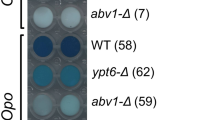Abstract
In previous studies we suggested the importance of the control of plasma membrane H+-ATPase by a phosphatidylinositol-like pathway for cellular proton extrusion in Saccharomyces cerevisiae (Brandão et al. 1994; Coccetti et al. 1998). The observations that provided the model above include the inhibition of the glucose-induced activation of the plasma membrane H+-ATPase as well as the inhibition of the glucose-induced external acidification by neomycin, a known inhibitor of the phosphatidylinositol turnover in eukaryotic cells. In this work, using two libraries, we isolated two yeast clones that were able to prevent the inhibition of glucose-induced activation of the H+-ATPase by neomycin. We show that the YOL002C gene, which encodes a protein of unknown function, and the SUL1 gene, which is a sulphate transporter belonging to the major facilitator superfamily, suppress growth inhibition by neomycin. However, they are not required for glucose-induced activation of the plasma membrane H+-ATPase. The resistance of the clones to neomycin is probably related to the level and/or activity of proteins functioning as drug extrusion pumps.
Similar content being viewed by others
References
Becher dos Passos, J., Vanhalewyn, M., Brandão, R.L., Castro, I.M., Nicoli, J.R. & Thevelein, J.M. 1992 Glucose-induced activation of plasma membrane H+-ATPase in mutants of the yeast Saccharomyces cerevisiae affected in cAMP metabolism, cAMP-dependent protein phosphorilation and the initiation of glycolisis. Biochimica et Biohysica Acta 1136, 57–67.
Bissig, M., Hagenbuch, B., Steiger, B., Koller, T. & Meier, P.J. 1994 Functional expressioncloning of the canicular sulfate transport system of rat hepatocytes. Journal of Biological Chemistry 269, 3017–3021.
Brandão, R.L., Magalhães-Rocha, N.M., Alijo, R., Ramos, J. & Thevelein, J.M. 1994 Possible involvement of a phosphatidylinositol-type signaling pathway in glucose-induced activation of plasma membrane H+-ATPase and cellular proton extrusion in the yeast Saccharomyces cerevisiae. Biochimica et Biophysica Acta 1223, 117–124.
Coccetti, P., Tisi, R., Martegani, E., Teixeira, L.S., Brandão, R.L., Castro, I.M. & Thevelein, J.M. 1998 The PLC1 encoded phospholipase C in the yeast Saccharomyces cerevisiae is essential for glucose-induced phosphatidylinositol turnover and activation of plasma membrane H+-ATPase. Biochimica et Biophysica Acta 1405, 147–154.
Del Sal, G., Manfioletti, G. & Scheneider, C. 1988 A one-tube plasmid DNA mini-preparation suitable for sequencing. Nucleic Acids Research 16, 9878.
Ito, H., Fukuda, Y., Murata, K. & Kimura, A. 1983 Transformation of yeast cells treated with alkali cations. Journal of Bacteriology 153, 163–168.
Karpicheve, I.V. & Small, G.M. 1998 Global regulatory functions of Oaf1p and Pip2p (Oaf2p) transcription factors that regulate genes encoding peroxisomal proteins in Saccharomyces cerevisiae. Molecular and Cellular Biology 18, 6560–6570.
Ketter, J.S., Jarai, G., Fu, Y.H. & Marluf, G.A. 1991 Nucleotide sequence, messenger RNA stability, and DNA recognition elements of cys-1A, the structural gene for sulfate permease II in Neurospora crassa. Biochemistry 30, 1780–1787.
Kolaczkowski, M., Kolaczkowska, A., Luczynski, J., Witek, S. & Goffeau, A. 1998 In vivo characterization of the drug resistance profile of the major ABC transporters and other components of the yeast pleiotropic drug resistance network. Microbial Drug Resistance 4, 143–158.
Kolarov, J., Kulpa, J., Baijot, M. & Goffeau, A. 1988 Characterization of a protein serine kinase from yeast plasma membrane. Journal of Biological Chemistry 263, 10613–10619.
Lapathitis, G. & Kotyk, A. 1998 Different sources of acidity in glucose-elicited extracellular acidification in the yeast Saccharomyces cerevisiae. Biochemistry and Molecular Biology International 46, 973–978.
Portillo, F. & Mazon, M.J. 1986 The Saccharomyces cerevisiae start mutant carrying the CDC25 mutation is defective in activation of plasma membrane ATPase by glucose. Journal of Bacteriology 168, 1254–1257.
Sambrook, J., Fritsch, E.F. & Maniatis, T. 1989 Molecular Cloning: A Laboratory Manual, 2nd edn. Cold Spring Harbor, New York: Cold Spring Harbor Laboratory Press. ISBN 0–87969–309–6.
Serrano, R. 1989 Structure and function of plasma membrane ATPase. Annual Review of Plant Physiology 40, 61–94.
Serrano, R., Kielland-Brandt, M.C. & Fink, G.R. 1986 Yeast plasma membrane ATPase is essential for growth and has homology with (Na+, K+), K+ and Ca2+-ATPases. Nature 319, 689–693.
Sigler, K. & Hofer, M. 1991 Mechanisms of acid extrusion in yeast. Biochimica et Biophysica Acta 1071, 375–391.
Smith, F.W., Howkesford, M.J., Prosser, I.M. & Clarkson, D.T. 1995 Isolation of a cDNA from Saccharomyces cerevisiae that encodes a high affinity sulphate transporter of the plasma membrane. Molecular and General Genetics 247, 709–715.
Sychorová, H. & Kotyk, A. 1985 Conditions of activation of yeast plasma membrane ATPase. FEBS Letters 183, 21–24.
Tanaka, T., Nakayama, K., Machida, K. & Toniguchi, M. 2000 Longchain alkyl ester of cAMP acts as an antagonist of glucose-induced signal transduction that mediates activation of plasma membrane proton pump in Saccharomyces cerevisiae. Microbiology 146, 337–384.
Thevelein, J.M. 1991 Fermentable sugars and intracellular acidification as specific activators of the RASD-adenylate cyclase signaling pathway in yeast: the relationship to nutrient induced cell cycle control. Molecular Microbiology 5, 1301–1307.
Ulaszewski, S., Hilger, F. & Goffeau, A. 1989 Cyclic AMP controls the plasma membrane H+-ATPase activity from Saccharomyces cerevisiae. FEBS Letters 245, 131–136.
Author information
Authors and Affiliations
Rights and permissions
About this article
Cite this article
Castro, I., Cabral, D., Trópia, M. et al. Yeast genes YOL002C and SUL1 are involved in neomycin resistance. World Journal of Microbiology and Biotechnology 17, 399–402 (2001). https://doi.org/10.1023/A:1016707627056
Issue Date:
DOI: https://doi.org/10.1023/A:1016707627056




